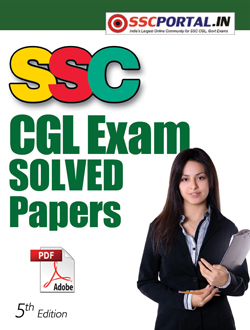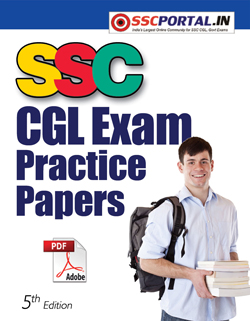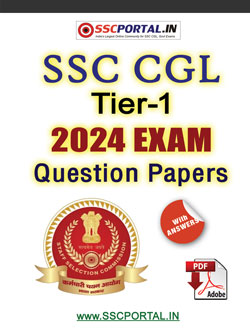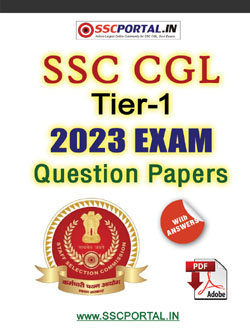NEW! SSC CGL PDF NOTES
SSC CGL EXAM Syllabus: Tier-1, Tier-2, Tier -3
SSC CGL Exam : Syllabus
SSC CGL Tier-1: Computer Based Examination (Preliminary)
This is your gateway to the SSC CGL selection process. The Tier 1 examination is an objective-type test conducted online, serving as the screening round for further stages.
Exam Pattern:
-
Duration: 60 minutes
-
Total Questions: 100 (25 questions from each section)
-
Total Marks: 200 (2 marks per question)
-
Negative Marking: 0.50 marks deducted for each wrong answer
-
Mode: Computer Based Test (CBT)
Subject Distribution:
-
General Intelligence and Reasoning: 25 questions (50 marks)
-
General Awareness: 25 questions (50 marks)
-
Quantitative Aptitude: 25 questions (50 marks)
-
English Comprehension: 25 questions (50 marks)
Special Link: Download Complete SSC CGL Tier-1 PDF Study Notes
SSC CGL Tier-2: Computer Based Examination (Mains)
Candidates who clear Tier 1 advance to this more challenging phase. Tier 2 consists of multiple papers, and the number of papers you need to attempt depends on your post preference.
|
Paper |
Who Should Appear |
Sections / Subjects |
|---|---|---|
|
Paper I |
All candidates |
Mathematical Abilities, Reasoning, English, General Awareness, Computer Knowledge, Data Entry Speed Test |
|
Paper II |
JSO applicants |
Statistics |
|
Paper III |
AAO applicants |
Finance, Accounts, Economics, Governance |
Detailed Tier 2 Paper I Structure
|
Section |
Module |
Questions |
Marks |
Duration |
|---|---|---|---|---|
|
Section I |
Mathematical Abilities |
30 |
90 |
1 hr |
|
Reasoning & GI |
30 |
90 |
||
|
Section II |
English Language |
45 |
135 |
1 hr |
|
General Awareness |
25 |
75 |
||
|
Section III |
Computer Knowledge |
20 |
Qual. |
15 min |
|
Data Entry Speed Test |
1 Task |
Qual. |
15 min |
Paper II (Statistics for JSO)
-
Data collection, sampling, central tendency, dispersion, correlation, regression, probability, time series, index numbers.
Paper III (Finance & Economics for AAO)
-
Finance and Accounts: Accounting basics, principles, terminology.
-
Economics & Governance: Indian economy, micro/macro economics, CAG, Finance Commission, money and banking, economic reforms.
Special Link: Download Complete SSC CGL Tier-2 PDF Study Notes
Detailed Syllabus
General Intelligence and Reasoning
This section evaluates your logical thinking and problem-solving abilities. The reasoning syllabus covers a wide range of topics that require both analytical thinking and quick decision-making skills.
Key Topics:
-
Analogies: Word analogies, number analogies, figure analogies
-
Similarities and Differences: Identifying odd one out in various formats
-
Space Visualization: Paper cutting, paper folding, figure formation
-
Spatial Orientation: Direction sense, distance and direction problems
-
Problem Solving: Blood relations, ranking and arrangement
-
Analysis and Judgment: Statement and conclusions, causes and effects
-
Decision Making: Syllogism, logical reasoning
-
Visual Memory: Figure completion, embedded figures
-
Discrimination and Observation: Pattern recognition, series completion
-
Relationship Concepts: Classification based on different criteria
-
Arithmetical Reasoning: Number series, coding-decoding
-
Verbal and Figure Classification: Grouping and categorization
Preparation Strategy: Focus on understanding the logic behind each type of question rather than memorizing solutions. Practice regularly with SSC CGL previous year papers to identify patterns and improve your speed.
Special Link: Access Premium SSC CGL Study Materials
General Awareness
This section tests your knowledge of current events and general knowledge spanning various fields. The general awareness syllabus requires consistent reading and updating of information.
Major Areas:
-
Current Affairs: National and international events of the past 6-12 months
-
History: Ancient, medieval, and modern Indian history, world history highlights
-
Geography: Physical geography of India and world, economic geography
-
Indian Polity: Constitution, political system, governance, public policy
-
Economics: Basic economic concepts, Indian economy, budget, and planning
-
Science: General science covering physics, chemistry, biology
-
Environment: Environmental studies, ecology, climate change
-
Sports: Recent achievements, tournaments, awards
-
Books and Authors: Important literary works and their creators
-
Awards and Honors: National and international awards
-
Important Dates: Historical events, national days, international days
Preparation Strategy: Create a daily reading habit covering newspapers, monthly magazines, and current affairs compilations. Use SSC CGL GK materials to build a strong foundation in static GK topics.
Quantitative Aptitude
Mathematics forms the backbone of this section, requiring strong conceptual understanding and computational skills. The quantitative aptitude syllabus covers fundamental mathematical concepts applied in real-world scenarios.
Core Topics:
-
Number System: HCF, LCM, prime numbers, divisibility rules
-
Percentage: Basic percentage, percentage change, successive percentage
-
Profit and Loss: Cost price, selling price, discount calculations
-
Simple and Compound Interest: Principal, rate, time calculations
-
Time and Work: Individual efficiency, combined work, pipes and cisterns
-
Time, Speed, and Distance: Basic motion, relative speed, trains, boats
-
Ratio and Proportion: Direct and inverse proportions, partnerships
-
Averages: Simple average, weighted average, age-related problems
-
Algebra: Basic algebraic identities, linear equations
-
Geometry: Lines, angles, triangles, quadrilaterals, circles
-
Trigonometry: Basic trigonometric ratios and identities
-
Statistics: Mean, median, mode, range, standard deviation
-
Data Interpretation: Tables, bar graphs, line graphs, pie charts
Preparation Strategy: Build conceptual clarity by understanding the fundamental principles behind each topic. Practice with SSC CGL mathematics papers to improve accuracy and speed.
English Comprehension
This section evaluates your command over the English language, including grammar, vocabulary, and reading comprehension skills. The English syllabus requires consistent practice and vocabulary building.
Key Components:
-
Reading Comprehension: Understanding passages, inferring meanings, drawing conclusions
-
Grammar: Parts of speech, tenses, voice, narration, articles
-
Vocabulary: Synonyms, antonyms, one-word substitutions, idioms and phrases
-
Sentence Correction: Error detection, sentence improvement
-
Fill in the Blanks: Context-based word selection, phrasal verbs
-
Spelling: Correct spelling identification, commonly misspelled words
-
Paragraph Completion: Logical sequence, coherent flow
Preparation Strategy: Develop a daily reading habit with quality English content. Focus on building vocabulary through SSC English preparation materials and practice grammar rules systematically.
Special Link: Get Comprehensive SSC CGL Study Kit
Subject-wise Preparation Tips
For Quantitative Aptitude: Start with basic concepts and gradually move to advanced problems. Use shortcut methods and tricks, but ensure you understand the underlying logic. Practice mental calculations to improve speed.
For Reasoning: Develop pattern recognition skills through regular practice. Focus on accuracy first, then work on improving speed. Create visual representations for complex problems.
For General Awareness: Maintain separate notebooks for different subjects. Create mind maps for better retention. Use mnemonics for remembering dates, facts, and figures.
For English: Read English newspapers daily to improve comprehension skills. Learn new words in context rather than isolated lists. Practice writing to improve expression skills for Tier 3.
Mock Tests and Practice Papers
Regular testing is crucial for exam success. Use SSC CGL mock tests to simulate exam conditions and identify your strengths and weaknesses.
Testing Strategy:
-
Take one full-length mock test every week during initial preparation
-
Increase frequency to 2-3 tests per week during the final month
-
Analyze each test thoroughly to identify error patterns
-
Focus on time management and question selection strategies
Special Link: Download Latest SSC CGL Study Materials
Online Resources and Digital Platforms
Leverage technology for flexible and comprehensive preparation:
-
SSC CGL Previous Year Papers: Analyze question patterns and difficulty levels
-
SSC CGL Mock Tests: Practice under exam conditions
-
Current Affairs Updates: Stay updated with latest developments
-
Study Notes: Quick revision materials for all subjects
Creating Your Personal Study Notes
Organize your resources effectively:
Physical Resources:
-
Subject-wise notebooks for important formulas and concepts
-
Separate folder for current affairs clippings
-
Practice paper collections sorted by difficulty level
Digital Resources:
-
Bookmark important websites and online materials
-
Create digital flashcards for quick revision
-
Use mobile apps for practice during travel time







